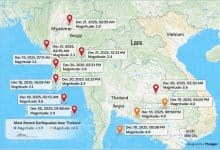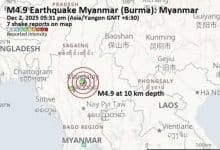Another earthquake further devastates Turkey and Syria

Another earthquake is further devastating Turkey and Syria just two weeks after the massive earthquake that hit the country on February 6.
Yesterday, a new magnitude 6.3 aftershock hit southern Turkey, killing at least three people and injuring hundreds more. The aftershock struck Turkey’s southern Hatay province, near the Syrian border, with its epicentre in the province’s Defne district. According to Turkish Interior Minister Süleyman Soylu, there have been 26 aftershocks since the quake.
Turkish officials say at least three people were killed and 294 people were injured following Monday’s aftershocks. In the city of Antakya, three men were trapped when a building that had survived the initial quake two weeks ago collapsed. The United States Geological Survey (USGS) initially reported the quake as being of magnitude 6.4 at a depth of 10 kilometres before revising it down to a 6.3 magnitude.
More than 130 people were injured in northwest Syria due to the aftershock, and a number of buildings also collapsed. The White Helmets volunteer rescue group said that their teams are working to take the injured to hospitals, inspect the affected villages and towns, and remove rubble to open the roads for the ambulances. Turkish Minister of Health Fahrettin Koca said on Twitter that 18 of the injured are in serious condition and were transported to Adana and Dörtyol. Koca said…
“I wish for our injured, patients, local people and all the people of our country to get well soon. May Allah ease our pain with health and well-being, and protect us from new pains and worries.”
Yaralılarımıza, hastalarımıza, bölge halkına ve ülkemizin bütün insanlarına tekrar geçmiş olsun dileklerimi sunuyorum. Allah, sağlık ve iyilikle acılarımızı hafifletsin, yeni acılar ve endişelerden korusun.
— Dr. Fahrettin Koca (@drfahrettinkoca) February 20, 2023
The mayor of Samandag said that some buildings had collapsed and that the mood was one of panic following the AFAD warning. CNN reported that its teams in Adana, Turkey felt the quake, as did eyewitnesses in Gaziantep and Mersin.
On Sunday, Turkey’s disaster management authority said it had ended most search and rescue operations nearly two weeks after the earthquake struck as experts say the chances of survival for people trapped in the rubble this far into the disaster are unlikely. Some efforts remain in the provinces of Kahramanmaraş and Hatay.
Efforts to retrieve survivors have been hampered by a cold winter spell across quake-stricken regions, while authorities grapple with the logistical challenges of transporting aid into northwestern Syria amid an acute humanitarian crisis compounded by years of political strife.
Turkey is located along tectonic plate boundaries and is no stranger to strong earthquakes. Seven quakes with a magnitude of 7.0 or greater have struck the country in the past 25 years. Monday’s quake is considered an aftershock as it is in the same general region and lower than the original 7.8 magnitude earthquake.
According to the USGS, “Aftershocks become less frequent with time, although they can continue for days, weeks, months, or even years for a very large mainshock.”
The death toll reported from the February 6 earthquake has already climbed to 46,957, according to ABC News. The most recent earthquake yesterday has now further devastated Turkey and Syria’s already dire situations.
Latest Thailand News
Follow The Thaiger on Google News:


























